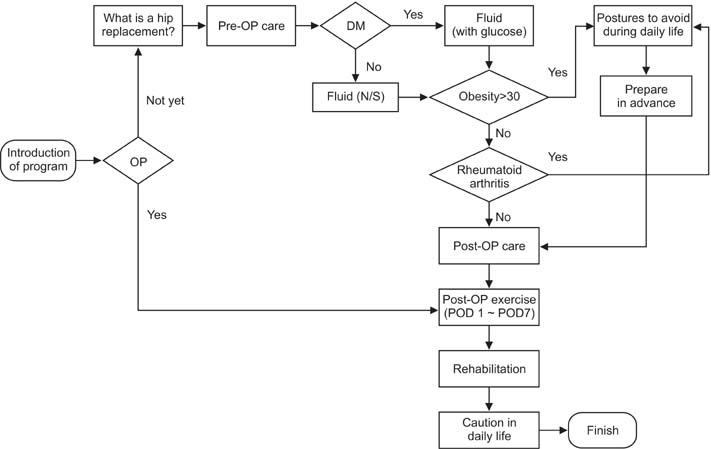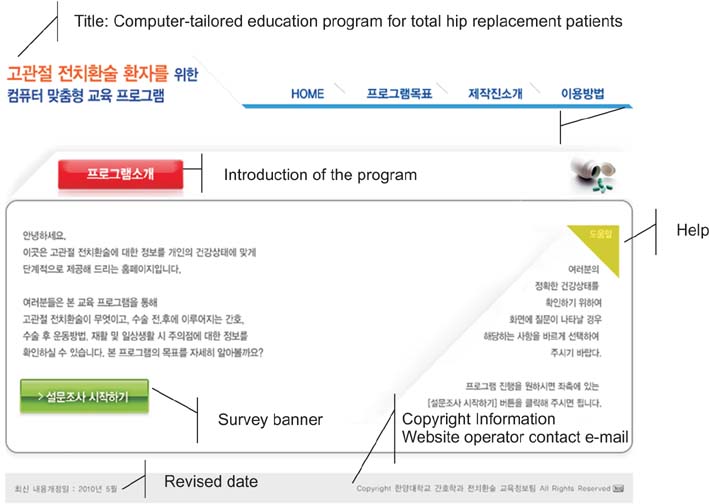Healthc Inform Res.
2014 Oct;20(4):258-265. 10.4258/hir.2014.20.4.258.
Development of Computer-Tailored Education Program for Patients with Total Hip Replacement
- Affiliations
-
- 1Department of Nursing, Graduate School of Hanyang University, Seoul, Korea.
- 2College of Nursing, Hanyang University, Seoul, Korea. joyhippo@hanyang.ac.kr
- KMID: 2166800
- DOI: http://doi.org/10.4258/hir.2014.20.4.258
Abstract
OBJECTIVES
The purpose of this study was to develop a Web-based computer-tailored education program to promote self-care for patients with total hip replacement.
RESULTS
Phase 1: Program content was developed, including the educational needs of patients with total hip replacement, based on a review of previous research and literature. Phase 2: A computer-tailored algorithm written as a series of 'if-then' statements was developed to offer the appropriate type of intervention based on an individual's personal health characteristics. Phase 3: A professional Web programmer produced then the program for use on the Web. Phase 4: An expert evaluation was performed focusing on two aspects, Web contents and website design. SPSS ver. 16.0 was used for the analysis, and grade point averages were used to compare each evaluation item. Phase 5: Based on comments from the experts' evaluation, modifications and revisions were made, and the program was completed.
CONCLUSIONS
The developed program presented tailored messages using animations, video and flash considering the individual health status and characteristics of the primary target generation. In addition, the expert evaluation confirmed the validity of the program's content and design.
Keyword
MeSH Terms
Figure
Cited by 1 articles
-
Cost-Effective Mobile-Based Healthcare System for Managing Total Joint Arthroplasty Follow-Up
Marina Bitsaki, George Koutras, Hansjoerg Heep, Christos Koutras
Healthc Inform Res. 2017;23(1):67-73. doi: 10.4258/hir.2017.23.1.67.
Reference
-
1. Kreuter MW, Farrell DW, Olevitch LR, Brennan LK. Tailored health messages: customizing communication with computer technology. Mahwah (NJ): Lawrence Erlbaum;2000.2. Eakin BL, Brady JS, Lusk SL. Creating a tailored, multimedia, computer-based intervention. Comput Nurs. 2001; 19(4):152–160.3. Kroeze W, Oenema A, Campbell M, Brug J. Comparison of use and appreciation of a print-delivered versus CD-ROM-delivered, computer-tailored intervention targeting saturated fat intake: randomized controlled trial. J Med Internet Res. 2008; 10(2):e12.
Article4. Oenema A, Tan F, Brug J. Short-term efficacy of a web-based computer-tailored nutrition intervention: main effects and mediators. Ann Behav Med. 2005; 29(1):54–63.
Article5. Spittaels H, De Bourdeaudhuij I, Brug J, Vandelanotte C. Effectiveness of an online computer-tailored physical activity intervention in a real-life setting. Health Educ Res. 2007; 22(3):385–396.
Article6. Brug J, Oenema A, Campbell M. Past, present, and future of computer-tailored nutrition education. Am J Clin Nutr. 2003; 77:4 Suppl. 1028S–1034S.
Article7. Suh KT. Total hip arthroplasty dislocation prevention and management. J Korean Hip Soc. 2006; 18(2):196–202.8. Jang JD, Lee SS, Choe JH, Yun TG, Lee CJ. Dislocation after total hip arthroplasty: a comparative matched study. J Korean Hip Soc. 2002; 14(2):128–134.9. Sadr Azodi O, Adami J, Lindstrom D, Eriksson KO, Wladis A, Bellocco R. High body mass index is associated with increased risk of implant dislocation following primary total hip replacement: 2,106 patients followed for up to 8 years. Acta Orthop. 2008; 79(1):141–147.
Article10. Zwartele RE, Brand R, Doets HC. Increased risk of dislocation after primary total hip arthroplasty in inflammatory arthritis: a prospective observational study of 410 hips. Acta Orthop Scand. 2004; 75(6):684–690.11. Bongartz T, Halligan CS, Osmon DR, Reinalda MS, Bamlet WR, Crowson CS, et al. Incidence and risk factors of prosthetic joint infection after total hip or knee replacement in patients with rheumatoid arthritis. Arthritis Rheum. 2008; 59(12):1713–1720.
Article12. McDonald S, Hetrick S, Green S. Pre-operative education for hip or knee replacement. Cochrane Database Syst Rev. 2004; (1):CD003526.
Article13. Yeh ML, Chen HH, Liu PH. Effects of multimedia with printed nursing guide in education on self-efficacy and functional activity and hospitalization in patients with hip replacement. Patient Educ Couns. 2005; 57(2):217–224.
Article14. Kim J, Kim E, Ko I, Kang SM. An evaluation study of hypertension information providing Web sites on the Internet. J Korean Soc Med Inform. 2003; 9(1):45–52.
Article15. Maclachlan K. WWW cyberguide ratings for content evaluation [Internet]. Howard (OH): CyberBee;2002. cited at 2010 Jan 12. Available from: http://www.cyberbee.com/content.pdf.16. McLachlan K. WWW cyberguide ratings for web site design [Internet]. Howard (OH): CyberBee;2002. cited at 2010 Apr 10. Available from: http://www.cyberbee.com/design.pdf.17. Seomun GA, Lee SJ, Lee SM. Evaluation of asthma-related websites. J Korean Soc Med Inform. 2004; 10(3):321–328.
Article18. Park HA, Kim HJ, Song MS, Song TM, Chung YC. Development of a web-based health information service system for health promotion in the elderly. J Korean Soc Med Inform. 2002; 8(3):37–45.
Article19. Yoo H, Jang Y. The content evaluation of tobacco cessation information on internet web-sites in Korea. J Korean Soc Med Inform. 2003; 9(4):431–444.
Article20. Lee J, Park M. Evaluation of rheumatoid arthritis information providing web sites on the Internet. Keimyung J Nurs Sci. 2007; 11(1):19–28.21. Quintana Y, Feightner JW, Wathen CN, Sangster LM, Marshall JN. Preventive health information on the Internet. Qualitative study of consumers' perspectives. Can Fam Physician. 2001; 47:1759–1765.22. Johansson K, Nuutila L, Virtanen H, Katajisto J, Salantera S. Preoperative education for orthopaedic patients: systematic review. J Adv Nurs. 2005; 50(2):212–223.
Article23. Kim MR. Strategies on screen design of learner-centered web-based instructional systems. J Educ Technol. 2000; 16(4):51–76.
Article24. Bae YS, Lee HJ. A study on web interface design to active internet usage of elderly in aging society. In : Proceedings of the 2004 Spring Conference Korean Society of Design Science; p. 66–67.25. Kim YH, Park MY. Analysis of interaction with menu structure and layout of screen on website for elderly. In : Proceedings of the 2006 Fall Conference of the Ergonomics Society of Korea;26. Park HA, Cho IS, Min ST, Kim JH. Development of a web-based Emergency medical information service program for health promotion. J Korean Soc Med Inform. 2005; 11(3):301–312.
Article27. Korea Internet Security Agency. 2013 Survey on the Internet usage executive summary. Seoul: Ministry of Science, ICT and Future Planning, Korea Internet Security Agency;2014.28. Lee HJ, Woo SH, Park EY, Suh HY, Baek SC. A study on the readability of web interface for the elderly user: focused on readability of typeface. J Korean Soc Design Sci. 2007; 20(3):315–324.
- Full Text Links
- Actions
-
Cited
- CITED
-
- Close
- Share
- Similar articles
-
- Do You Need CAOS (Computer Assisted Orthopedic Surgery) in THA?: From a Negative Perspective
- Total Hip Replacement for Ankylosed and Deformed Hip
- The Scientic Basis and Problem in Total Hip Replacement
- Posterior Approach to Total Hip Joint Replacement Arthroplasty
- Modified Posterior Approach to Total Hip Arthroplasty





